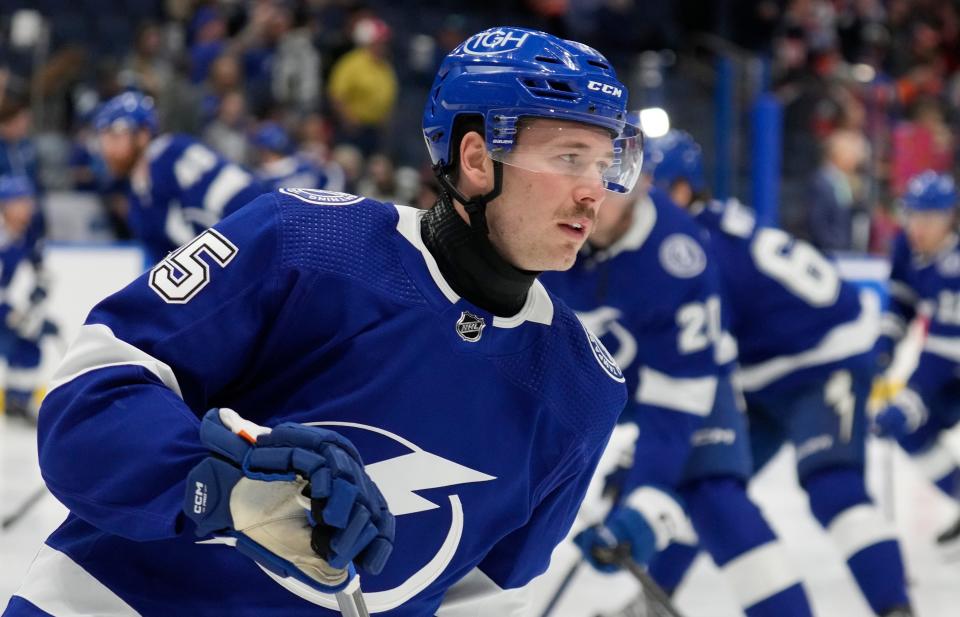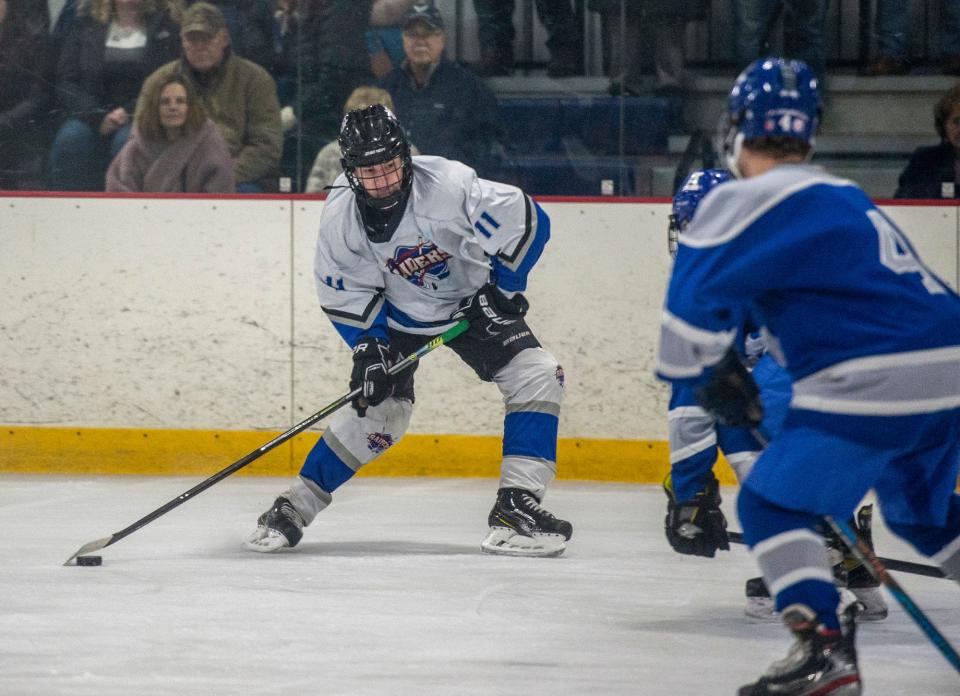Some Massachusetts ice hockey coaches 'in full support' of implementing neck guard mandate
The region’s ice hockey coaches and athletic directors reacted positively to USA Hockey’s mandate that all players under 18 wear neck laceration protection, effective Aug. 1. While the decision does not affect schools within the Massachusetts Interscholastic Athletic Association – which is governed by the National Federation of State High School Associations (NFHS) - the idea has its supporters.
Neck protection is a key discussion topic after former NHL player Adam Johnson died in an English elite game after his neck was cut by an opponent’s skate blade in October. Current NHL players Rasmus Dahlin, TJ Oshie and members of the Winnipeg Jets and Pittsburgh Penguins – Johnson's former team – began wearing neck guards in the immediate aftermath of Johnson’s death.
The death of Connecticut player Teddy Balkind in 2022 – the result of a skate blade to the neck – is another reminder of player safety.
While few are seen at local high school games, the popularity of neck guards will take some time to grow.

“I am in full support of making neck guards mandatory,” said Franklin boys coach Chris Spillane. “After the several horrific injuries, I think it will become a common piece of equipment. Once the youth players start, we will see a continuation at the high school level down the road.”
“Starting this mandate through USA Hockey will make it easier for players to adjust to wearing the neck protection,” added Marlborough boys coach Mike O’Brien. “Over time, this will just become a part of the players’ equipment.”
To O’Brien’s point, any change to rules – or players’ attitudes toward neck gear – will take time.
Framingham High athletic director Paul Spear, who sits on the MIAA’s Hockey Committee, which met virtually on Tuesday morning, said before the meeting the idea of adopting a new rule is worth exploring.
“No one likes change, however, given what’s happened, my feeling is we should be taking a long hard look at it,” Spear, a former hockey coach at Framingham, said in a text.
Mike Nanartowich, Hudson’s boys coach for more than 30 years, backed the idea.
“I’m surprised the MIAA did not mandate them after (Johnson’s) injury,” he said. “I’m in full support of them.”
MIAA tables discussion of neck guards until spring
The topic of neck protection, among other seasonal subjects, was discussed for 10 minutes at Tuesday’s Hockey Committee meeting. The committee ultimately decided to stand pat and revisit the issue in the spring, opting to wait until more information is available on whether the guards are effective in reducing major injuries.
Richard Pearson, the MIAA’s associate executive director, said during the meeting that just six state high school associations – including Connecticut, New York and New Jersey – currently mandate neck protection.
He said factors that are keeping the MIAA from recommending rule changes are the scarcity of available equipment – “You can’t buy them. You go to a shelf, and there’s two,” he said – and the different kinds available: standalone collars, guards with bibs attached, and others that are part of a shirt worn underneath uniforms (turtleneck).
Committee member Dan Shine, who retired last year after coaching at Arlington Catholic for 43 years, said the topic was discussed last spring, but not enough information on neck protection’s effectiveness was available.
“We had doctors come in and give us their opinion,” he said during the meeting. “As of last spring, no one was able to pinpoint whether or not a throat/neck protector would save an individual from a serious laceration. The concern was, the actual protector – if the skate got caught under it – if the skate got pulled out, in turn, it could actually make things worse.”
Bob Ware, another committee member, suggested keeping the subject on the agenda “and see what data comes from it in the spring and go from there.
“From my experience, the National Federation, anything to do with safety, they usually jump right on. When it’s safety, it becomes the top priority: to protect the high school athlete. But this isn’t something they jumped at because there was no data to back it up. I’m sure it will be a hot topic; there will be a lot of discussion about this.”
Committee member Scott Palladino brought up NHL goalie Clint Malarchuk’s severed jugular due to a skate blade during a 1989 game. Malarchuk lost a lot of blood, but his life was saved by a quick-acting medical staff.
“There was a push then for these neck guards and there were studies that showed that they could cause more harm,” Palladino said.
Player says mandating neck guards may be ‘overreaction’
Hopedale/Milford junior Aiden Collins missed all but one game of his freshman season when his left wrist was cut by a skate in a game against Grafton/Blackstone Valley Tech on Dec. 14, 2021. After surgery repaired tendons and nerves, Collins returned to play in a game exactly a year after his injury.
He says he doesn’t wear wrist or neck guards “because they are very uncomfortable and would affect how I play,” and added that similar injuries can be fluky.

“Some people don’t understand how getting cut by a skate is such a rare thing and is a complete accident,” he said. “Having experienced it I feel like my opinion could differ from some people. I don’t think they are a bad thing at all, but I personally think requiring them is response to a complete accident could be seen as an overreaction.”
Spear reiterated that many high school players may not choose to wear the protection without enforcement.
“If players aren’t mandated, they’d likely elect not to wear them and that’s a choice,” he said. “Hockey players are usually thinking it won’t happen to them and are risk takers almost by nature, so unless there is a mandate, I don’t see too many teenagers wearing these electively.”
Algonquin girls coach Tina Beauchemin said she was required briefly to wear a neck guard as a younger player, but that soon disappeared due to an "uncomfortability factor." But she supports the idea of a state mandate.
"Obviously, safety is the utmost priority for any child, and so as a coach I am a proponent of this change," she said, "although I would hope that they have developed a better design than in my day. If something can be designed that can prevent this type of result that is comfortable and not restrictive to the player, it is something that should be highly considered as positive, especially for anyone under 18."
Whether the state decides to adopt a mandate remains to be seen. But it appears the sight of covered necks may become part of player equipment soon.
“I’m beginning to see more players who I coach at every level wearing neck guards,” said Algonquin boys coach Greg Cappello. “My hope is that, with cut-resistant fabrics being more accessible and with new rule changes, we’ll see all players wearing them in the near future.”
Tim Dumas is a multimedia journalist for the Daily News. He can be reached at tdumas@wickedlocal.com. Follow him on Twitter @TimDumas.
This article originally appeared on MetroWest Daily News: Area hockey coaches support neck guard mandate; MIAA awaits more data

